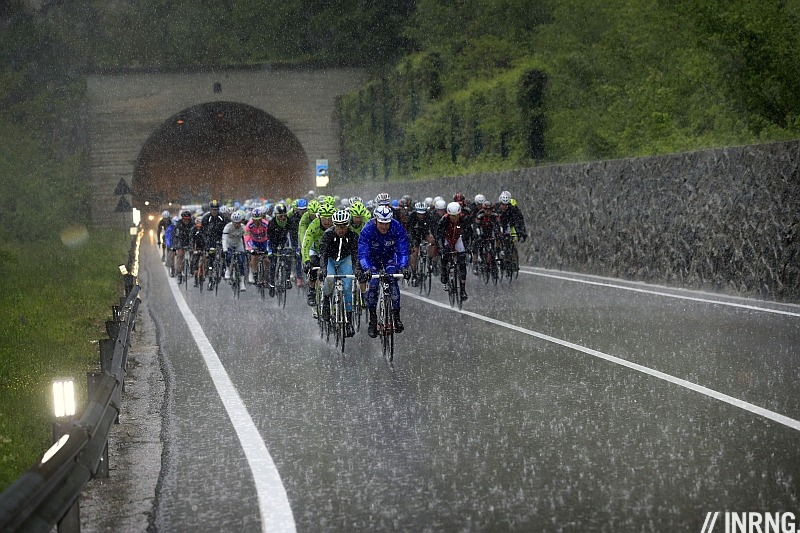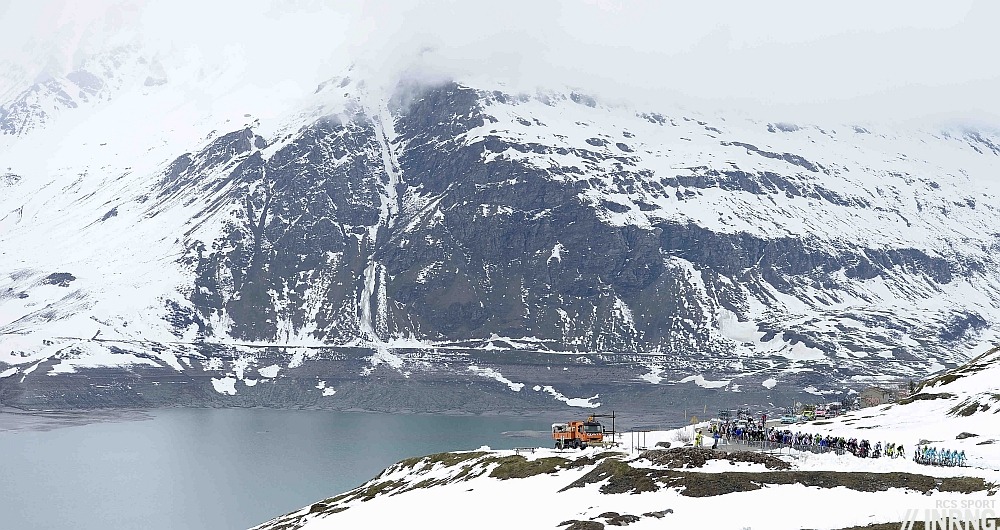 It has to be the wettest racing season living memory. Anecdotes aside, meteorological data show high rainfall for Italy and France and the Tour of Switzerland has seen a stage modified because the road was still closed by snow. There are signs the bad weather is changing and summer must starting as the French air traffic controllers are on strike today, frustrating riders trying to get to the Tour of Luxembourg and the Route du Sud.
It has to be the wettest racing season living memory. Anecdotes aside, meteorological data show high rainfall for Italy and France and the Tour of Switzerland has seen a stage modified because the road was still closed by snow. There are signs the bad weather is changing and summer must starting as the French air traffic controllers are on strike today, frustrating riders trying to get to the Tour of Luxembourg and the Route du Sud.
So before the weather hots up, here’s a quick look at an item of pro kit that’s not often featured: the rain bag.
This is a small bag belonging to each rider containing the clothing they need on a damp day. It’s packed into the team car and can be brought out when rain falls. The pro cyclist’s version of an umbrella.
“Instead of expressing their gratitude for the rain by getting wet, people walk around with umbrellas.”
Tim Krabbé, The Rider
Krabbé might have a point but few cyclists will express gratitude when it starts raining in a race. Now a cyclist can’t use an umbrella but there’s a range of waterproof gear available.
When travelling each rider has their own suitcase for a race with their clothing and personal effects, plus there’s some common “stock” of team kit that travels in a truck like spare jerseys or helmets in case these get ruined by a crash. But riders have particular items for a rainy day and in the back of the car each rider has a dedicated “rain bag.” It depends on the team and the rider but here’s what you’ll find inside:
- rain jacket
- gilet
- “Gabba” style rain jacket
- arm warmers and knee warmers
- spare shoes, perhaps an older and dirtier pair
- cap
- gloves
- helmet
- overshoes
- Clear sunglasses
The idea is that a rider can drop back to the team car and pick up the supplies they need, either for themselves or for team mates. Jackets, gloves and shoes are all individual to a rider and they need these spares in the team car, just as the team car carries spare wheels and oil. Often the bag will include multiple items, for example two pairs of gloves so that once the first pair are soaked through a rider can hope to have dry hands again, perhaps in time for a long Alpine descent. The bag is always in the car even if the weather is good because a rider needs spare shoes in case of a crash.
And here’s @thejensie prepping his rain bag for the race. #tourdesuisse twitter.com/vanderjeugd/st…
— Tim Vanderjeugd (@vanderjeugd) June 9, 2013
Some riders hate riding in the rain, some dislike it, some try to profit from it knowing that others hate it more than you do. Few tend to enjoy riding in the rain but at this time of year it is part of the job. Having warm and dry clothes on hand is essential.
Rain rules
One other thing to note is the UCI rules on rain jackets. They’re supposed to be clear or in the team design. But in practice we see a lot of black or blue jackets being used. Riders aren’t allowed to cover their race numbers either but the whole point of putting a jacket on is to put a layer on so the commissaires can and do fine riders for wearing a jacket.
Oil
There are other tricks for the rain. Oil is one. There’s the chain of course where mechanics will smear grease onto the chain as this is less likely to get washed out. They’re also doing the same with electronic gears although, anecdotally at least, we still seem to spot a few failures when the clouds open.
A similar thing is done for the rider where oils and embrocations are used. Sheep survive on wet hillsides thanks to their wool and lanolin and derivative products can be used for riding in the rain. The legs can be covered but an old trick is to cover the lower back and the kidney area, they say it stops a chill.
Extra Work
It’s no fun for the riders but they’re not the only ones suffering. Team mechanics have more work to do when cleaning the bikes and it’s also their duty to clean the team vehicles during a race too. The rain means more work and they’re probably going through even more cleaning products than usual. Think twice before buying an ex-team bike at the end of 2013.
Soigneurs have their extra work too, having to wash more kit and maybe on a longer cycle to ensure the gear comes out clean. It might depend on the team but riders are often left to clean their shoes.
Back in the Day
Those of a nostalgic nature might say it was sunnier in the past but things have changed. Read Paul Kimmage’s “Rough Ride” and amongst the shock of doping, race fixing and bungling team managers, it’s astonishing to read that he’d finish a stage of the Giro and then hand-wash his own jersey in the hotel room, as if riding for hours in the cold rain wasn’t enough work.
Go back further and the peloton wore wool. The material can still perform very well today, especially as a base layer, but you probably wouldn’t wear shorts or jerseys. Riders with too much in the back pockets would find the jersey sagging lower and lower.


You can do it too. I have a bag in my wardrobe with old shoes and gloves that comes out for the rain.
Always wondered, are domestics allowed to use mudguards?
If a team knows that the whole day will be wet, then are domestics allowed to use mudguards (or fenders) to stop continually spraying their team leader in trains? If you’re a team leader on a transition stage, I’d guess riding ~200km in continual spray from others wheels can’t be nice (it’s never nice on a wet Sunday morning pack run). I’m guessing a team leader or sprinter wouldn’t due to weight/vanity/aero advantage, but are they banned under UCI rules, or is it just a not done thing?
Hasn’t Lars Bak been spotted with a rear mud guard this spring?
Ah, this one: http://www.flickr.com/photos/kristoframon/8574395844/
Think that would help keep your own bum crack a little drier/warmer, but can’t imagine it being very effective for yourself or anyone around you!
Ahh, the ass saver, see http://ass-savers.com/
I’ve spotted it on Milano-Sanremo and decided to buy it. It’s truly magical piece of plastic that keeps your ass dry. Only ass 😉 but it improves comfort a lot. Best spend € this year 🙂
He did. I think it was during the Milano-San Remo. It was just a small mud guard on the back of his saddle – very clever.
Technically “modifications” are not allowed but as Ad says, one or two riders have been spotted with a small “ass saver”:
http://www.sporza.be/cm/sporza/videozone/sporten/wielrennen/1.1577298
Traditional mudguards arent allowed, but some riders used those mini splash Ass Saver guards under their saddles at MSR this year
the rain is only a problem if you don’t want to get wet 🙂
i love the cok
I enjoy riding in the rain. But riding in the rain and getting oh so cold is miserable. Black rain jackets should be banned on public roads for ordinary mortals.
Yes, black is dangerous when visibility is already poor. I try to avoid traffic in poor conditions, and use a blinking rear light. Don’t want to be run off the road (again).
The Ass Saver actually reduces the chill factor in the lower back and kidney area.
The Secret Pro blog over on cycling tips is now saying that all the teams that were ‘unofficially’ using unbranded Gabba jerseys during the classics aren’t allowed to any more – some angry sponsors stomping on it.
I’m sure we’ll see some Gabba clones coming out from other companies soon.
Thanks for bringing the Secret Pro to my attention. A great read.
You can add shorts to your list of items kept in the team car. Maybe not rider specific, but certainly some new pairs for general use. After Johnny Hoogerland had his argument with the barbed wire in the 2011 TdF he finished the stage in a new pair of team shorts.
Exhibit ‘A’
http://www.joepassmore.com/wp-content/uploads/2011/07/tour-de-france-johnny-hoogerland-crash-pic-reuters-709105660.jpg
Exhibit ‘B’
http://cdn2.media.cyclingnews.futurecdn.net/2012/06/01/2/spz10.pain.tdw154346_600.jpg
The Omega Pharma Quickstep team have a good video about the content of their riders rain bags here: http://www.youtube.com/watch?v=dnh7Fr2nMww (first 2 min or so).
Joe Lindsey’s Boulder Report blog had a good post about Gabba and similar new generation rain gear here: http://bicycling.com/blogs/boulderreport/2013/04/05/the-forecast-calls-for-better-gear/.
Thank doG for Gore Tex! ….and fenders for us mortals.
I have a Gore Bike Wear Oxygen jacket and a Xenon half-sleeve jacket. The Oxygen gets pulled out in the colder months. The Xenon gets the nod for temps over 50f. You wouldn’t think a half-sleeve waterproof jacket would be so darn useful, but it is! You don’t get nearly as hot under it while still staying mostly dry.
No such thing as bad weather, just inadequate gear
How much fun is it to read this blog?
I used to always smear by lower back with Vaseline for racing in the rain – it’s much heavier than ‘normal’ oil, so never seemed to be absorbed by base layers and kept the rain off a bit better. I was never a fan of putting warm embrocation anywhere other than my legs, but you used to see guys rubbing it into places that must have been uncomfortably warm on even the coldest days!!
The only reason I hate the rain is because my bike gets dirty!!
Pure lanolin, like Waxoil for the knees.
Agree with, with Bikehound Rain is okay but oh the bike.
I don’t rust but in the “old days” the bikes did…
I don’t mind training or racing in the rain…it’s only the muddy
spray in the face that is annoying, especially as you’re trying
to maintain clear-as-possible visibility at high speeds!
As for gear; I have a tried-and-trusted Castelli rain jacket that has
a virtually anatomical fit, but see others, including pro’s, riding with
what appears to be something they converted out of a parachute!
Me don’t get it…unless it is the purpose to keep their pace in check!
I agree it’s dumb for mortals to ride in the rain in all black. Thank Castelli for the fluo Gabba. I wonder why other companies with the fancy fabrics don’t follow suit and release their rain jerseys in hi-viz colors.
I like riding in the rain, but not all year long.
Racing in the rain, not as much.
In the pacific northwest, full wrap rear fenders with “buddy flap” extensions are mandatory on group rides, or you’re asked to ride on the back end. For racing they come off, but it would be nice to see full fenders during cold wet races. Many bikes now feature hidden fender mounts, especially “endurance” bikes